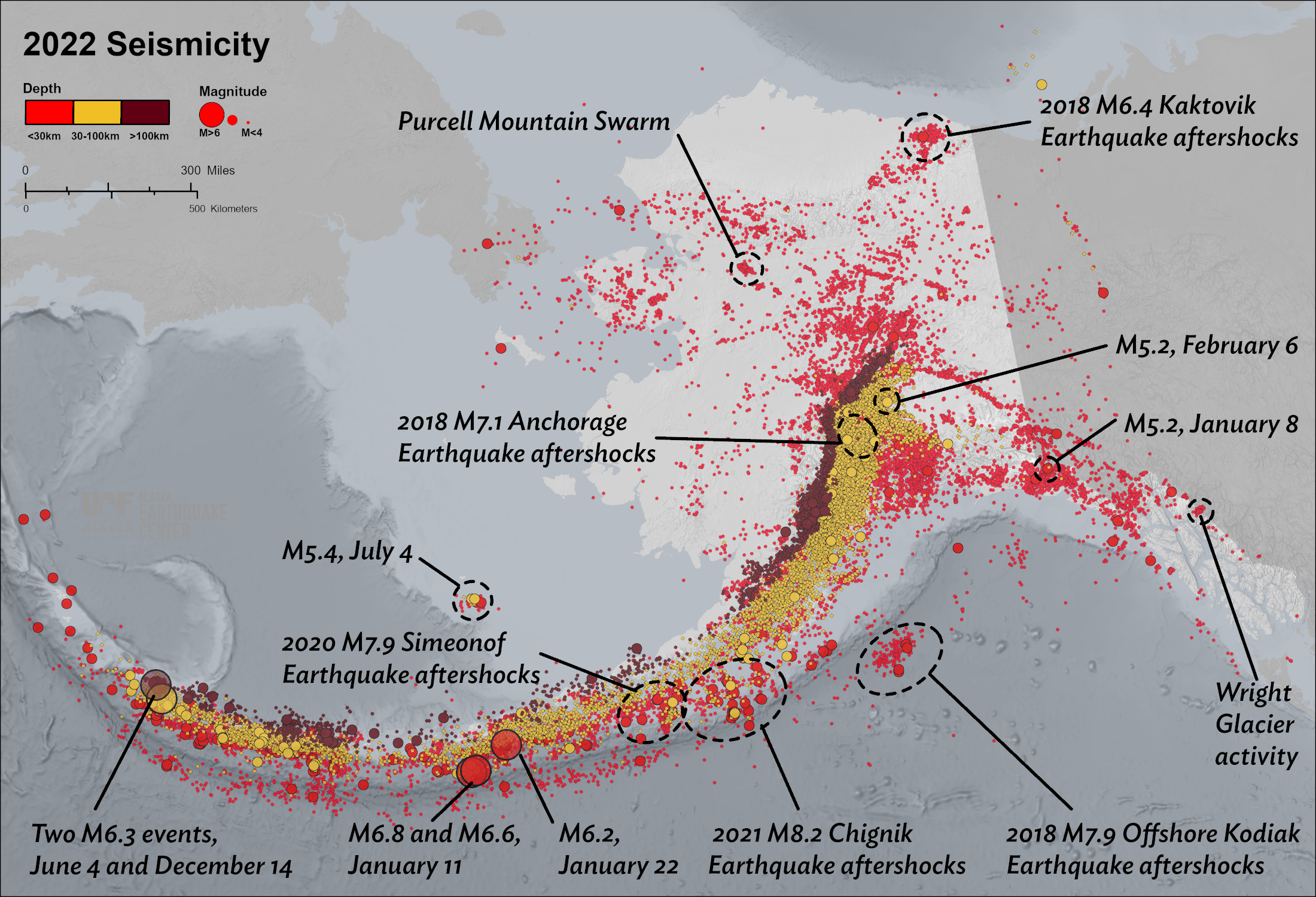
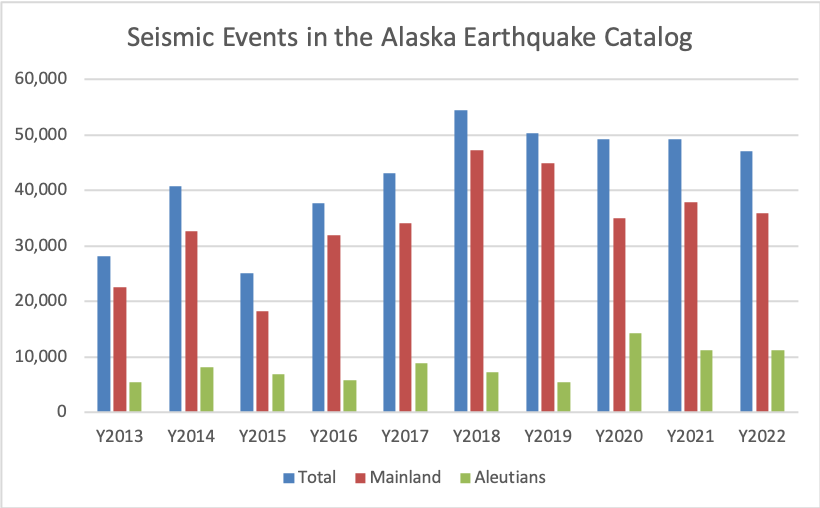
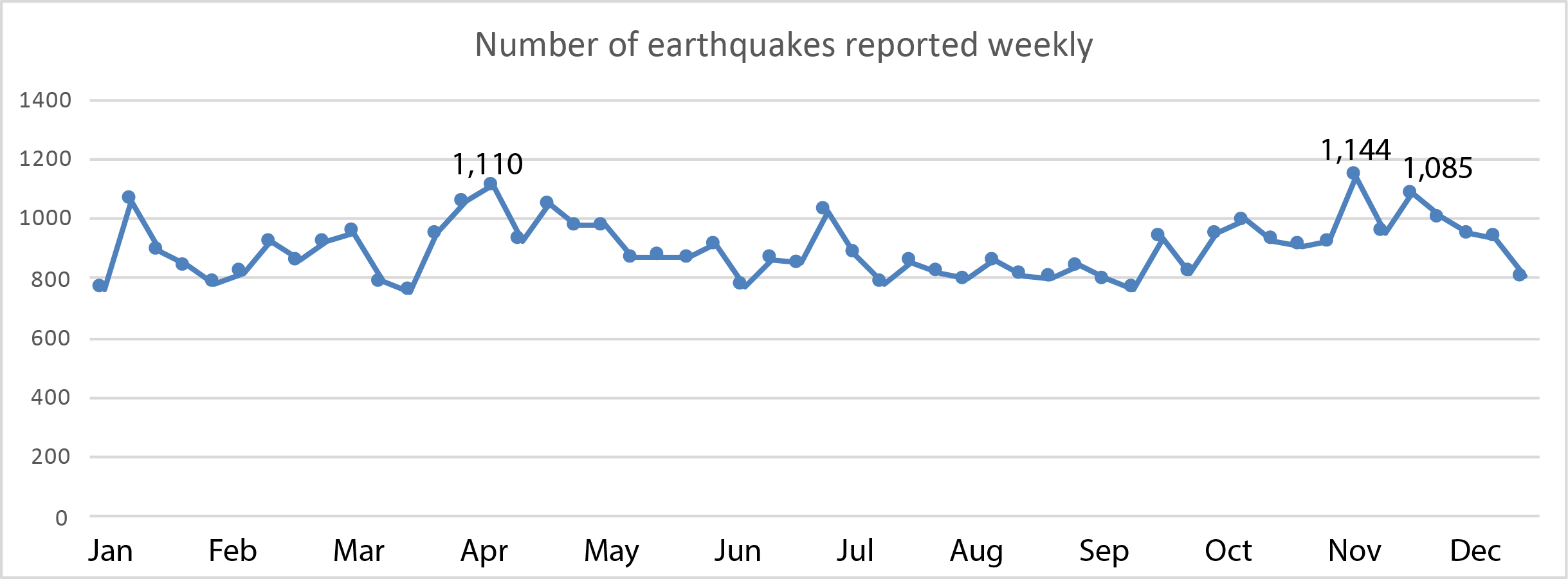
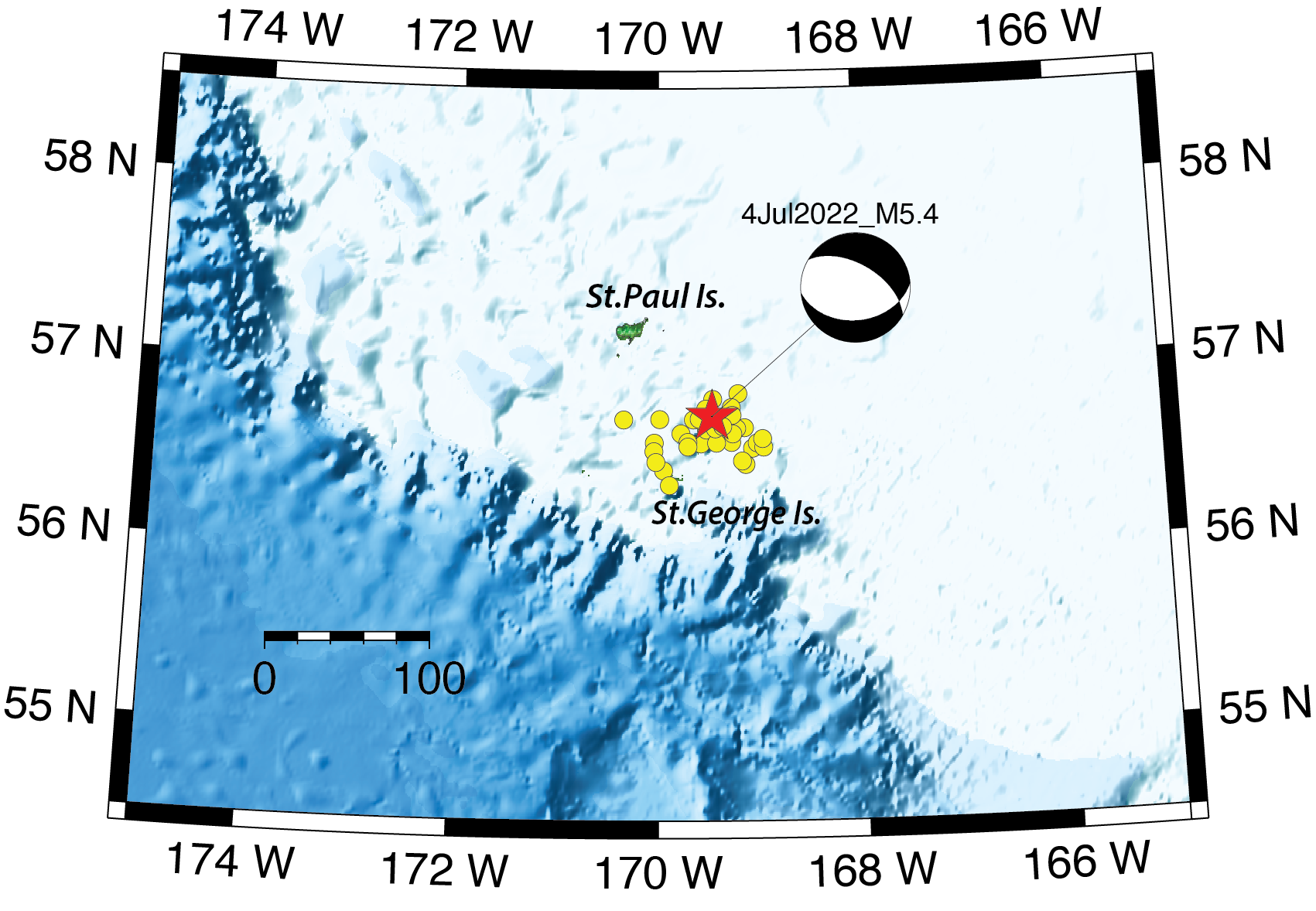
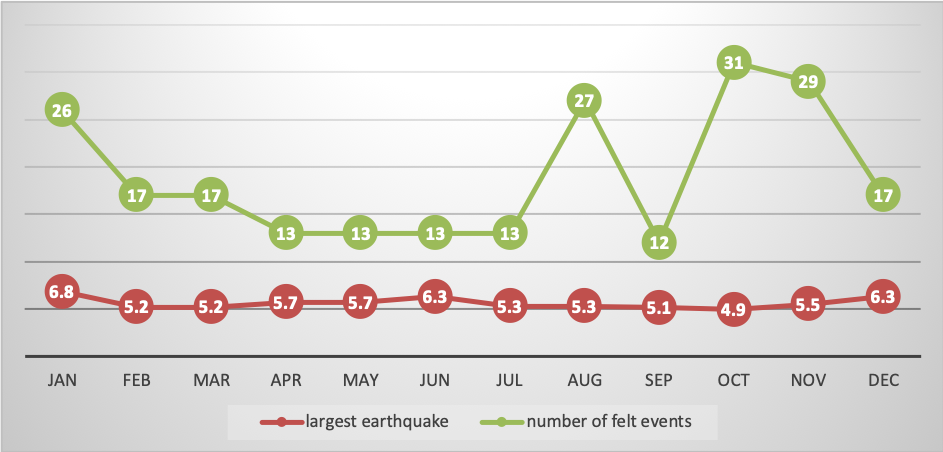

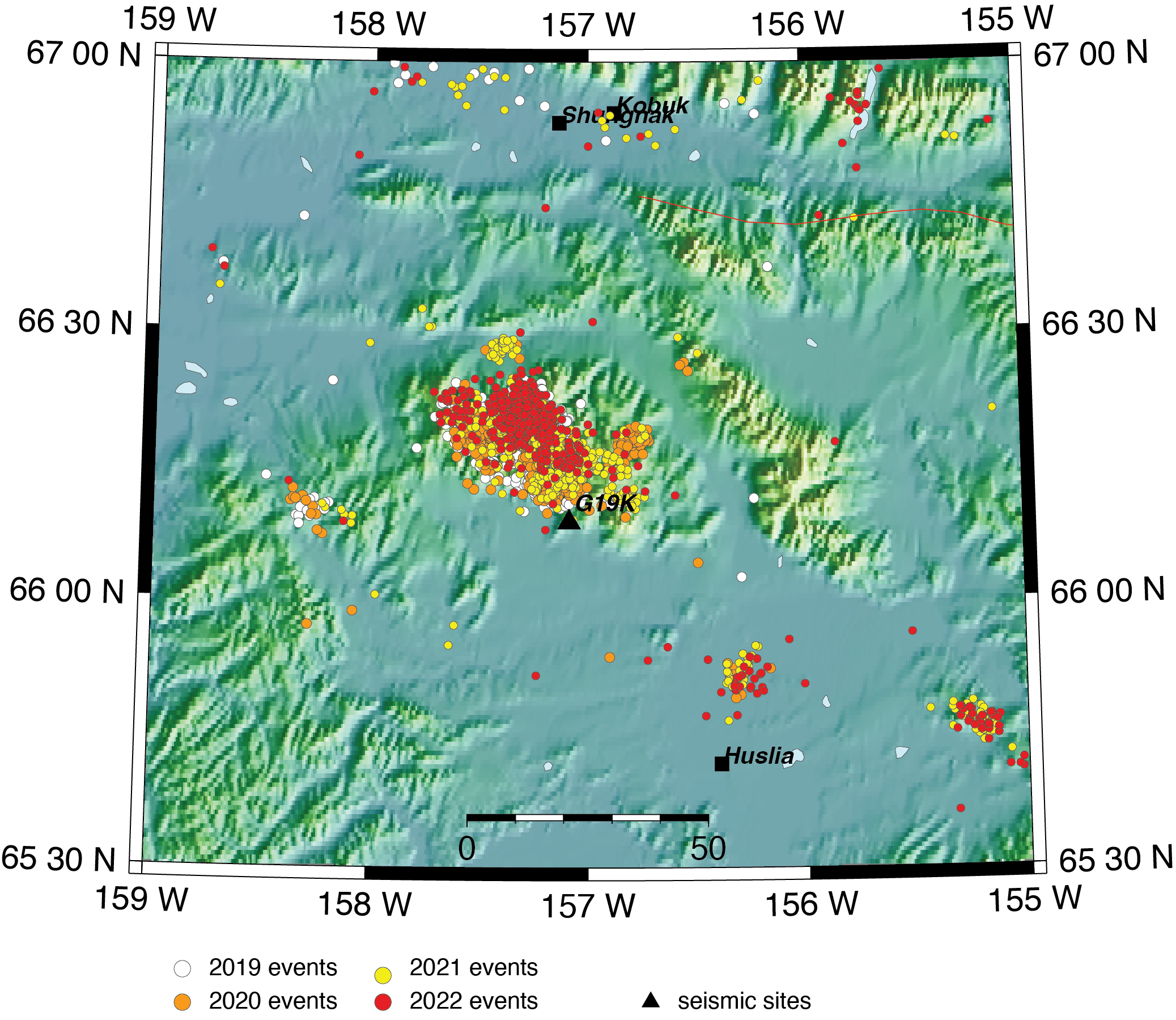
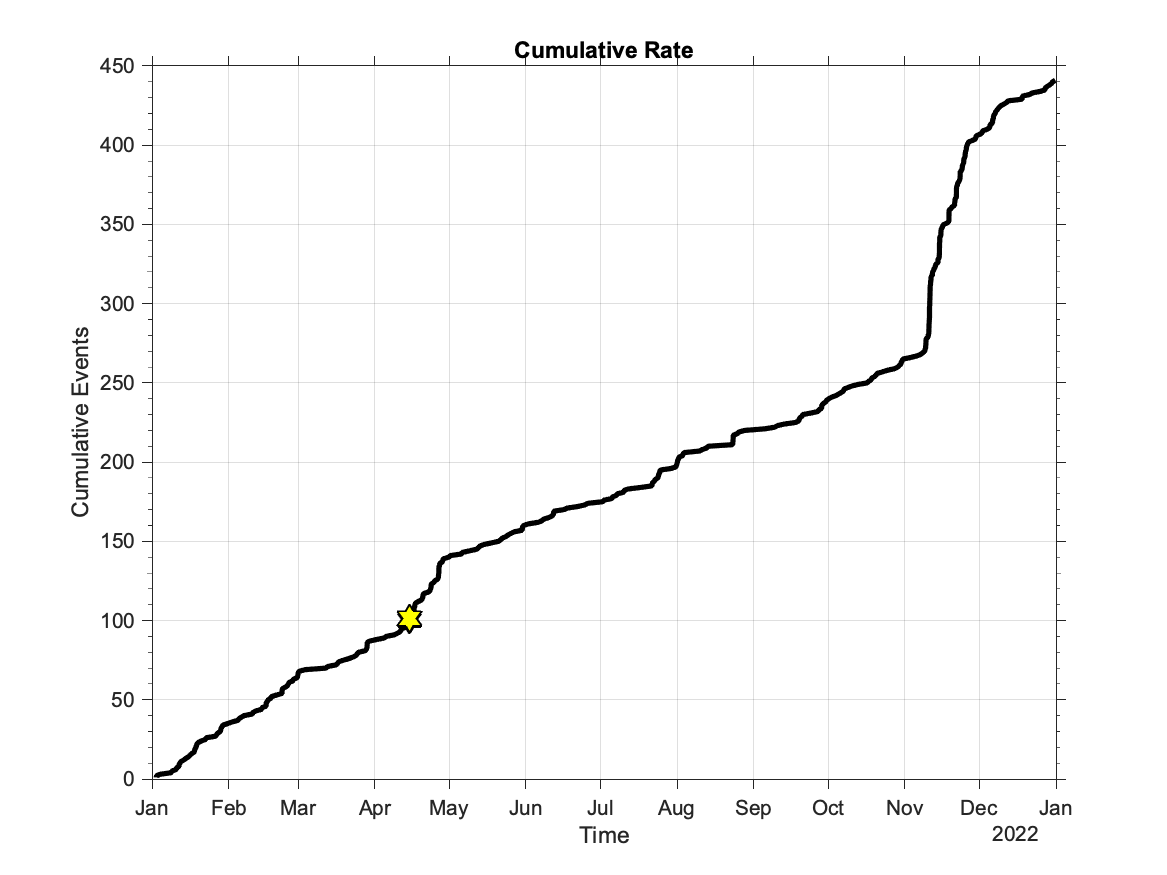
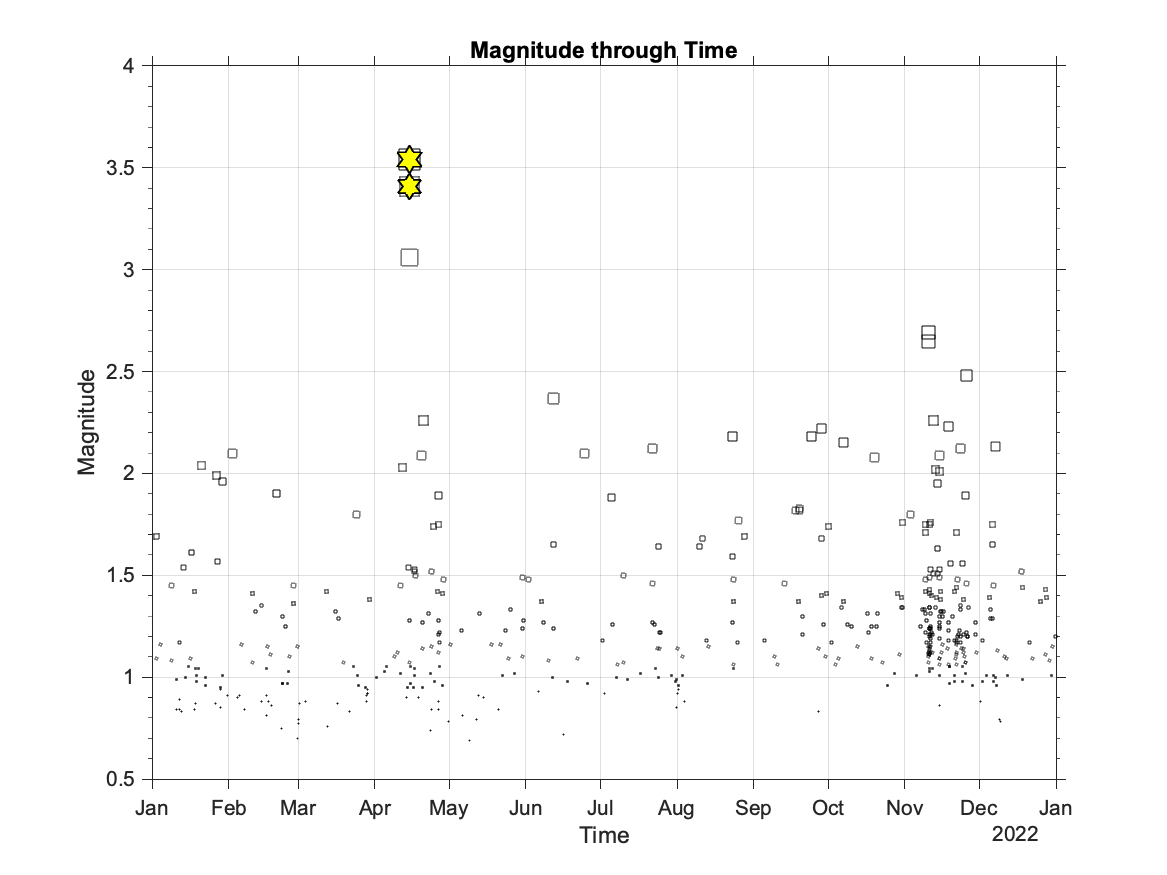
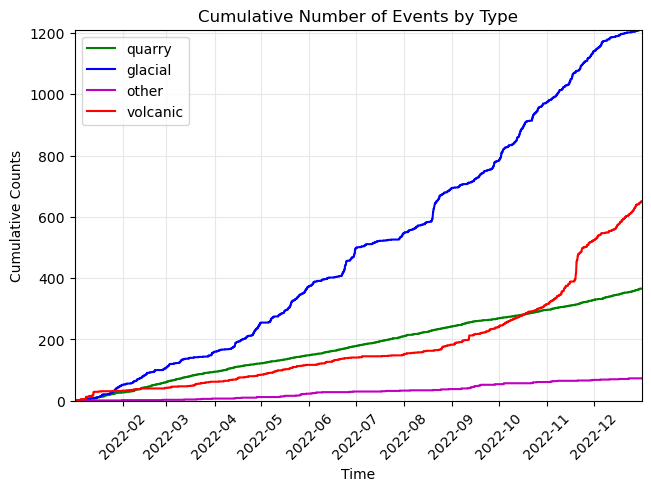

Alaska had a relatively quiet 2022 as far as earthquakes go. Overall, the Alaska Earthquake Center reported 47,045 seismic events in Alaska and neighboring regions in 2022 (Figure 1). This makes it the state’s fifth largest year, coming in behind 2018 (about 55,000 seismic events), 2019 (about 50,000 seismic events), 2020 (about 49,250 seismic events), and 2021 (about 49,000 seismic events) (Figure 2). Throughout the year we averaged 902 reported earthquakes per week (Figure 3), which is slightly less than in the previous 3 years. The Earthquake Center’s data analysts picked and cataloged 1,484,054 seismic phases, about the same number as in each of the previous 3 years.
The Aleutian Islands were the most active region, holding the title for the largest earthquake of 2022, a magnitude 6.8 on January 11 in the Fox Islands area. Other active spots in the Aleutians included two M6.3 earthquakes in the Rat Islands on June 4 and December 14, both of which were followed by moderate aftershock sequences. The Earthquake Center also recorded a magnitude 5.4 earthquake in an unusual location in the Bering Sea, east of St. George Island, on July 4 (Figure 4).
The two largest earthquakes in mainland Alaska both measured magnitude 5.2, one in the Yakutat Bay region on January 8 and one in central Alaska on February 6. We continued to monitor ongoing activity within the 2018 M7.1 Anchorage, 2018 M6.4 Kaktovik, 2018 M7.9 Offshore Kodiak, 2020 M7.6 Simeonof, and 2021 M8.2 Chignik aftershock sequences; the Purcell Mountains earthquake swarm; and the Wright Glacier cluster northeast of Juneau.
Between 12 and 31 earthquakes per month were reported felt in Alaskan communities (Figure 5), with magnitudes of these events ranging from as small as 2.0 to as large as 6.8. The largest number of Did You Feel It responses, 1,869, came from the M4.9 earthquake that occurred on November 18 at 6:09 p.m AKST (00:03:09 UTC) 14 miles (22 km) northwest of Anchorage. The largest earthquakes each month ranged from magnitude 4.9 in October to 6.8 in January (Figure 5).
2021 M8.2 Chignik aftershock sequence
A magnitude 8.2 earthquake struck offshore of the Alaska Peninsula on July 29, 2021, the largest earthquake in the U.S. in 50 years. In 2022 we reported about 397 aftershocks for the Chignik aftershock sequence (Figure 6), an average of about 8 events per week. About 10 aftershocks had magnitudes greater than 4.0. The largest aftershock, a magnitude 5.2, occurred on February 20. While the rate of the aftershocks continued to decline through 2022, we expect this sequence to extend through 2023.
2020 M7.8 Simeonof aftershock sequence
The Simeonof Earthquake continued to produce the most active ongoing aftershock sequence with about 1,563 reported aftershocks between magnitude 1.0 and 5.2 (Figure 6). About 10 aftershocks had magnitudes greater than 4.0. The largest aftershock, magnitude 5.2, occurred on February 3. The M7.6 aftershock cluster continues to be more active than the larger M7.8 patch. While the rate of the aftershocks continued to decline through 2022 and was about half of that of 2021, we expect the Simeonof aftershock sequence to extend through 2023.
2018 M7.1 Anchorage aftershock sequence
Aftershocks from the November 30, 2018 magnitude 7.1 Anchorage Earthquake continued into their fourth year at an average pace of about 14 earthquakes per week, which is about 20% less than in 2021. The largest aftershock, a magnitude 5.0, occurred on November 18. Approximately 700 aftershocks were reported in 2022, bringing the total count for the sequence to more than 14,000 aftershocks. About 20 of these aftershocks were reported as felt in 2022. While the original estimates for the duration of this aftershock sequence were about 2-2.5 years, the seismicity rate remains elevated compared to the background rate prior to the M7.1 earthquake. We expect this sequence to continue at a decreasing rate in 2023.
2018 M6.4 Kaktovik aftershock sequence
We continued to record aftershocks of the 2018 M6.4 Kaktovik Earthquake, the largest earthquake ever recorded on the North Slope. During 2022, we reported about 188 aftershocks, bringing the sequence up to approximately 7,500. The largest aftershock was a M4.1 on March 15. In the fourth year of this aftershock sequence we registered about 4 events per week on average, which is about 40% less than in 2021. The activity is still above background level and we expect this sequence to continue in 2023 at a decreasing rate. Due to its low activity of less than 1 event per day on average, we will not be tracking this sequence in future reports.
2018 M7.9 Offshore Kodiak aftershock sequence
We continued to record aftershocks of the 2018 M7.9 Offshore Kodiak Earthquake, a complex strike-slip rupture on a series of conjugate faults and fractures. During 2022, we reported only about 206 earthquakes, bringing the sequence up to approximately 5,650. The largest aftershock was a M4.9 on February 3. The aftershock rate in 2022 was 30% less than in 2021 at about 4 events per week on average, however it is still above the background level and we expect this sequence to continue in 2023. Due to its low activity of less than 1 event per day on average, we will not be tracking this sequence in future quarterly or annual reports.
Purcell Mountains earthquake swarm
The Purcell Mountains Swarm, which began in March 2019, had about 441 events in 2022 (Figures 7, 8, 9), which is less than half of what was recorded in 2021. The activity rate continued at an average pace of about 8 earthquakes per week, with a period of increased activity in November-December, bringing the sequence total to more than 9,600 events. The largest events in the swarm during 2022 were a M3.4 and a M3.5 on April 15, with only one other earthquake registering larger than M3.0.
Earthquakes caused by tectonic plate or fault movement make up the majority of the events the Earthquake Center detects, but our sensitive seismic instruments also capture shaking from other sources. In 2022, we reported 2,301 seismic sources that were classified as something other than regional tectonic earthquakes (Figure 10). These included:
1,211 glacial quakes (magnitudes M=0.5-3.0), primarily located in the Prince William Sound, Icy Bay, and Yakutat Bay regions, and near Wright Glacier northeast of Juneau.
651 seismic events associated with volcanic activity (M=0.3-4.6).
366 suspected quarry blasts (magnitudes M=0.3-2.5), the majority of which were located in the vicinity of Fort Knox and Healy mines in Interior Alaska.
73 events were classified as “other” type (M=0.5-2.9). Two of these events were confirmed large landslides. One occurred on September 15, 2022 near Seward on the Kenai Peninsula and another on September 19, 2022 in the Glacier Bay National Park region in Southeast Alaska.
Glacial seismicity is being recorded and studied globally; Alaska is no exception due to its large expanse of glaciated areas. In 2022, we reported over 1,200 glacial quakes, ranging in magnitudes up to M3.0. We normally record the majority of glacial activity near the termini of tidewater glaciers such as in the Prince William Sound region, Icy Bay, and Yakutat Bay (Figure 11). This activity follows seasonal variability and peaks at different times in different areas (Figure 12). This year the pace of glacial seismicity picked up in April and did not subside until December. This year, glacial seismic activity in Prince William Sound peaked much later in the season in October-November. Seasonality within the Icy Bay and Yakutat Bay regions was similar to previous years, although slightly higher activity was observed in the mid-fall.
Wright Glacier
We continued to record events in a cluster under Wright Glacier, which is about 40 miles (64 km) northeast of Juneau. A few of these events reached magnitudes between 2.8-2.9 and were felt in Juneau. The 2022 activity picked up in late May and had 3 different episodes of elevated rates: in late June, late August, and again in October (Figure 12). This year, activity continued much later into the season than observed in 2020 or 2021. Periodic seismicity in this area has been observed since the 1970s, with event rates usually peaking in summer and early fall. These quakes tend to cluster near the Speel River, where it drains glaciated areas of Mt. Ogden. The levels of activity, however, are not the same every year. Seismicity rates observed in 2020-2022, for example, have not been observed since 2011-2012.










